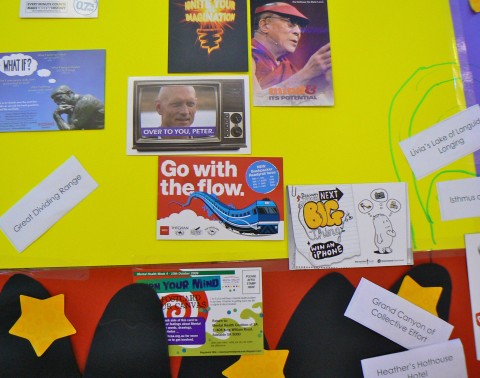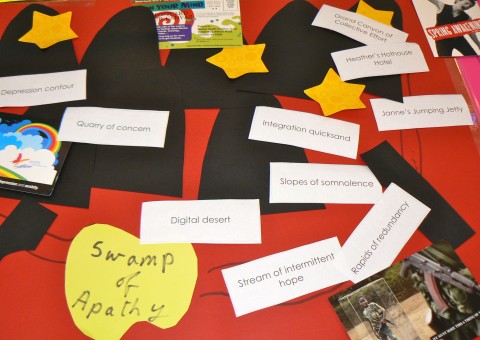In Transit
I like working with transitions of all kinds – new structures, services, systems. When things are in flux, new possibilities arise. Even as a child, I loved the spaces between things, the liminal spaces. Like flying between two cities or countries; or hanging out in the neglected spaces that tend to grow between two solid forms. And, in my work, I’ve always loved those moments when something changes dramatically – a merger, a divestment, a new CEO – and all that was seemingly solid just melts away. In thinking about and working with these transitional moments, I’ve been influenced by the work of William Bridges. The trajectory described by Bridges – of an ending, a neutral zone, and a new beginning – is elegant and useful. He distinguishes the different mind states that accompany the structural aspects of the change process, and the individual psychological transitions needed to support it.
goodbye comfort zone
Lots of energy, time and money is lavished on the structural aspects of change and transition, the big overarching communication plans and strategies, while the interstices often get overlooked. But that’s where the best opportunities for experimentation can be found. Sure, these transitional moments are unsettling and emotionally complex, but isn’t this the terrain out of which all creative endeavours arise? Just ask any artist, writer, designer or performer – it’s not a self satisfied business plan shrouded in certainty that gets the creative juices flowing, it’s usually the tension inherent in the ‘not-knowing’ where to start that stimulates the creative energy needed to start. In other words, it’s a bit of a paradox; discomfort can be an important catalyst for human creativity. I’m not suggesting a binary opposition here: structured planning vs creative experimentation. When it comes to transitions, they can coexist. But they often need to coexist in different zones, different parts of the brain, and these zones need to be cultivated with a conscious approach. In 2011, I worked with a team undergoing a major transition. My client, the Victorian Government Library Network, which had previously been a loose consortium of department-based libraries with their own systems, processes and single-client focus, was brought together under one shared service provider model nestled into the Treasury and Finance portfolio. Big systems changes were planned, along with the merger of the previously independent library services. Over a year, we were able to cultivate a more experimental and overtly ‘right hemisphere’ approach to transition.
the map of experience
We did many things together over the year, but one stood out; I called it ‘the map of experience’ after a powerful book I bought in the late 1990s by Dutch geographers Louise Van Swaaij and Jean Klare. Using large coloured cardboard sheets, an electric mix of postcards freely sourced from cafés and art galleries, and geographic signposts such as the ‘quarry of concern’ or the ‘swamp of apathy’, the executive team constructed a collective ‘map’ that embodied their hopes, fears and perceptions about the road ahead. The next step involved using the same technique with the broader leadership team, which contained more unsettled views about the merger. Another collective map was constructed, with surprisingly little resistance or delay. The two groups came together with their respective maps; a difficult conversation ensued, but one that had an electric resonance. It was a turning point in terms of commitment to the process, and I’ve spent many months reflecting on why. My theory is that all the previous joint meetings had mainly focused on the technical, systems-related, structural and procedural aspects of the merger, encasing the emotional content behind a hard shell of cynicism and fear.
The map of experience was primarily a visual and kinaesthetic process, inviting the feelings-oriented right hemisphere to contribute valuable insights to the change process. These insights were illuminating, and led to a series of subsequent workshops that combined free expression with a more light-hearted planning mode.
bumpy but exciting
According to neuro-psychiatrist Iain McGilchrist, while each hemisphere’s specific capabilities are critical to learning, knowledge creation and knowledge sharing, it is the right hemisphere alone that can apprehend the new. Of course, it needs the left hemisphere to apply language and context to what is perceived and imagined, but without this capacity to apprehend new stimuli we would never innovate or even survive. Translating the experience or insight of ‘newness’ into language other people can understand, requires something subtler than utilitarian words or frameworks. If these are relied on in the early stages of creative insight, the subjective and imaginative component is denuded or lost. McGilchrist sings the praises of metaphor in this context. The ‘map of experience’ is essentially a collective metaphor-making technique; it allows the hidden to become visible, and once out in the open spaces of free conversation, it brings a burst of fresh energy to the bumpy road every transition must traverse if real change is desired.
References:
Bridges, W. (1997) Managing Transitions: Making the Most of Change, Nicholas Brearly Publishing, London
McGilchrist, I. (2009) The Master and his Emissary: The Divided Brain and the Making of the Modern World, Yale University Press, New Haven
Van Swaaij, L. & Klare, J. (2000) The Atlas of Experience, Bloomsbury, London




